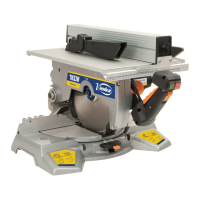10
Ensure that the machine is disconnected
from the mains before carrying out any
preparation or maintenance work on
the machine.
5.1 INSTALLATION
Once you have unpacked the machine, fasten its handle
to the swinging arm as shown in the diagram on the
attached label.
When using the machine in a fixed location we re-
commend that it be secured to a table or workbench
at a height of approximately 90 cm using the holes
C located in the base (Fig. 2). To facilitate your work,
we recommend using our MOVABLE WORKING TABLE
MT58K (ref 5800100) (Fig. 29). The machine is designed
exclusively for interior working and as such should not
be exposed to rain or humid environments.
5.2 HANDLE
Place the handle of the machine in working position by
releasing the knob A (Fig. 8). Rotate the handle to the
top position and tighten knob A.
5.3 UNLOCKING THE HEAD
Lightly press the handle in the direction of the cut and
turn the transport locking catch B (Fig. 6) clockwise until
it reaches the stop, then follow the machine as it moves
up to until it is locked in resting position.
5.4 CHECKS
Before connecting to the mains ensure that the protectors
and safety mechanisms on the machine are working
correctly and check that the voltage corresponds to
that shown on the characteristics plate.
If an extension cable is being used check that the cross
section of the wires are suitable for the nominal current
of the machine.
6. ADJUSTING THE MACHINE
Ensure that the machine is disconnected
from the mains before carrying out any
adjustments.
The mitre saw leaves the factory adjusted; however
further adjustments can be made with the mechanisms
described below.
6.1 ADJUSTING THE TILTING HEAD
To adjust the saw blade to 90° with respect to the
machine table, place a square between the two and
proceed as follows:
Release the handle D (Fig. 2) and correct any deviation
using screw E. The head can also be adjusted to 45° with
respect to the table by turning screw F (Fig. 2).
6.2 ADJUSTING THE REVOLVING PLATE
The machine is equipped with an automatic lock at 0°,
15°, 22.5°, 30° and 45° so that these positions should
only rarely need adjustment. If this is necessary, lock
the machine at 0° and release screws G which hold in
place rule H; move the rule until it is perpendicular to
the saw (Fig. 10).
6.3 ADJUSTING THE MAXIMUM CUTTING DEPTH
The maximum cutting depth is determined by the ad-
justing screw I (Fig. 2). This should be readjusted every
time the saw blade is changed or sharpened.
- Check that the saw is not touching the
bottom of the plate once the maximum
depth has been adjusted.
- Change the cover on the plate when it
is worn or broken.
6.4 ADJUSTING THE KEEL
To adjust the keel proceed as follows:
- Remove cover V using screws W (Fig. 9).
- Release screws X (Fig. 7), adjust the keel and tighten
up the screws which secure it; then replace the cover V.
- The distance between the teeth of the
saw blade and the keel must never be
greater than 5 mm.
- Use only saw blades whose body is
thinner than the thickness of the keel
and at the same time whose teeth are
wider than this thickness.
6.5 ADJUSTING THE MAXIMUM
RAISED POSITION
To adjust the maximum raised position turn screw
Y (Fig. 2) remembering that the machine locks into
resting position.
6.6 LASER GUIDE
The machine is fitted with a laser guide that works in
conjunction with the saw blade, projecting a light beam
onto the material to be cut, indicating the line for the
saw blade with great precision. Match the light beam
up with the line previously drawn for cutting.

